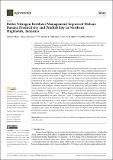Better nitrogen fertilizer management improved Mchare banana productivity and profitability in northern highlands, Tanzania

View/
Date
2023-05-20Author
Meya, Akida
Swennen, Rony
Ndakidemi, Patrick
Mtei, Kelvin
Merckx, Roel
Metadata
Show full item recordAbstract
Declining land productivity is a major problem constraining banana (Musa spp.) production
in Tanzania. Banana fruit yield consequently reaches only 15% of the potential, primarily due to
inadequate soil nutrient replenishment. Improving farmers’ soil nutrient replenishment strategy in
banana home gardens, which relies on applications of cattle manure only, by mixing with inorganic
fertilizer resources can increase land productivity and can improve the overall profitability of banana
production in the country. Experiments were conducted at Tarakea, Lyamungo, and Tengeru to
determine the effects of organic fertilizer resources (animal manure and crop residue) and their
combination with inorganic fertilizer resources on the productivity and profitability of Mchare
banana production. Banana fruit yield differed significantly among the experimental sites, with drier
areas of Tengeru recording, on average, 19.6 t ha−1 year−1
, while the more humid areas of Lyamungo
recorded, on average, 39.3 ha−1 year−1
. Mchare banana plants grown under sole inorganic fertilizer
produced significantly low yields (33.0 t ha−1 year−1
) compared with those fertilized with cattle
manure only, which lifted the yields to 38.8 t ha−1 year−1
, but the latter required more labor input.
Soil nitrogen (N) fertilization via cattle manure + mineral fertilizer gave the highest average banana
fruit yield (43.0 t ha−1 year−1
) across the sites, and reduced fertilization costs by 32%. Subsequently,
this integrated fertilization technique generated the highest average net benefits in all sites and both
cropping cycles. Thus, the findings of this study form a basis to improve land productivity and
profitability in banana-based home gardens in the study area by directing more labor input to good
soil N management
